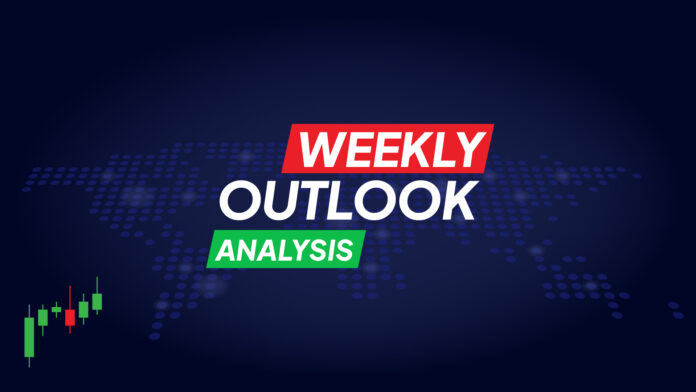Key points to watch out for:
- Recession fears subside as investors focus on Jackson Hole
- Eurozone and UK PMIs to influence ECB and BoE forecasts
- Canadian inflation could support BoC’s third straight rate cut
- Japan’s national CPI is also on the calendar
Jackson Hole Will Test the Fed’s Most Pessimistic Bets
After the unwarranted panic caused by the weaker-than-expected July NFP report, investors have taken a calmer stance, re-analyzing their aggressive Fed rate cut bets as incoming data indicate that the U.S. economy is not performing as poorly as initially thought.
Two weeks ago, investors were expecting rate cuts of up to 125 basis points by the end of the year, though they have since slightly revised this estimate. They now expect rates to fall by about 100 basis points, which remains a considerably pessimistic outlook, implying a reduction at each of the remaining decisions in 2024, including a 50 basis point cut.
The possibility of a double cut at the next meeting in September currently stands at around 25%, and this action is almost completely discounted for December. With this in mind, investors are looking ahead to the Fed’s Jackson Hole Economic Symposium, to be held from August 22-24.
The theme will be the reassessment of the effectiveness and transmission of monetary policy, suggesting that investors will hear extensive commentary, not only from Fed Chairman Jerome Powell and his colleagues but also from other leading central bankers.
With inflation hovering around 3%, it will be interesting to see if Powell and other Fed members remain confident in the downward trajectory of price pressures. If they do, how they plan to move forward will be crucial. Even if Powell indicates that a September rate cut remains possible, it is unlikely to satisfy those anticipating hints of a double rate cut, meaning Treasury yields and the U.S. dollar could continue to rise.
Equity traders may be particularly eager to hear Powell’s views on the U.S. economy, especially after the recent turmoil. Further assurances that recession risks are high could push Wall Street higher, even if expectations for lower borrowing costs are scaled back.
The minutes of the latest Fed meeting will be released on Wednesday, August 21, but investors are likely to focus more closely on the Jackson Hole symposium for more current information and signals. Preliminary August S&P Global PMIs will be released on Thursday, August 22, and may also attract attention as investors remain anxious about the state of the world’s largest economy.
PMIs Are Also at the Forefront of Investors’ Attention
On Thursday, August 22, preliminary PMI indices for both the Eurozone and the UK will also be released. Regarding the Eurozone, the ECB decided to keep interest rates unchanged at its last meeting. Although President Lagarde did not commit to any cuts in September, she expressed pessimism about the growth outlook in the region.
This led investors to almost fully price in another 25 basis point cut in September, and a series of downbeat PMIs could confirm this outlook. Market participants are also likely to be keenly interested in the minutes of the latest ECB decision, which will be released later in the day, to find clues on how policymakers plan to proceed.
In the UK, the Bank of England cut interest rates on August 1, though it indicated it will be cautious about further rate cuts. Data last week showed the unemployment rate fell to 4.2% from 4.4%, and headline inflation picked up to 2.2% year-on-year from 2.0%, despite the core rate falling to 3.3% from 3.5%.
The data confirmed the Bank of England’s view, though there remains about a 30% chance that policymakers will opt for another rate cut on September 19. For this likelihood to increase, the PMIs may need to show a significant deterioration in business activity.
Will CPI Data Halt the Canadian Dollar’s Recovery?
Canada’s CPI figures will be released on Tuesday, August 20, followed by retail sales data on Friday, August 23. The Bank of Canada has cut interest rates by 25 basis points at each of its most recent decisions, leaving the door open for further action.
Investors expect the Bank to continue cutting rates in each of the remaining decisions this year, and a further slowdown in inflation could lend additional credibility to that expectation, potentially weighing on the Canadian dollar.
Currently, the oil-linked currency is primarily supported by the rebound in oil prices, driven by supply concerns due to rising tensions in the Middle East and the easing of demand-side concerns as fears of an economic recession subside. Consequently, since a moderate trend is already priced in by the Bank of Canada, it is unlikely that a further slowdown in inflation will significantly alter current expectations.
Japan’s CPI Inflation Also in Focus
Finally, on Friday, August 23, during the Asian session, Japan will release its July CPI figures. According to Tokyo data, it is highly likely that headline inflation slowed, while underlying prices continued to accelerate. If this trend is reflected in the figures, the likelihood of the Bank of Japan raising rates again in the final months of the year could increase.
However, even if this leads to a stronger yen, the recent easing of investor appetite makes it unlikely that the Japanese currency will experience a similar rally to that seen in recent weeks.
Interest rates in Japan remain very low relative to other major central banks, providing some market participants with the opportunity to use the yen as a funding currency while increasing their exposure to risk.



